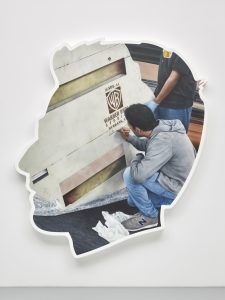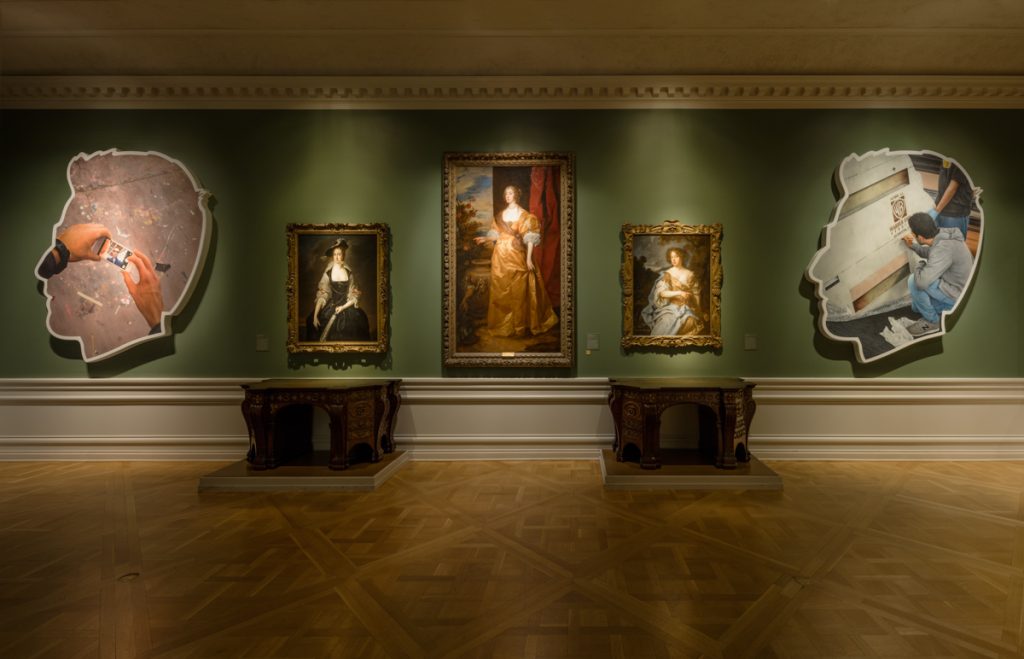Loan Program
Alex Israel at The Huntington
The Huntington Library San Marino, CA December 12th, 2015
The Brant Foundation Loan Program
The Huntington Library San Marino, CA
December 12, 2015 – July 11, 2016

Alex Israel, Self Portrait (Signature), 2014, Acrylic and bondo on fiberglass, 96 x 84 x 4 inches
PRESS RELEASE: Alex Israel at The Huntington on view Dec. 12, 2015, through July 11, 2016, will integrate a significant group of Israel’s works—including paintings (freestanding and mural) and sculpture in sizes ranging from five inches to 16 feet—throughout the Beaux Arts building that once served as the residence of Gilded Age collectors Henry E. and Arabella Huntington and, for the past eight and a half decades, as the gallery for a priceless European art collection.
“More than just a showcase for Alex’s work, this exhibition is intended to spark a dialogue between the new and the old—the one informing the other—that is both a provocation and a love letter,” said Kevin Salatino, Hannah and Russel Kully Director of the Art Collections at The Huntington. “Alex’s practice addresses celebrity culture and the iconography of L.A. through the conceptual lens of Warhol and Duchamp. The staging of his work within the historic mansion—the paradigmatic Hollywood set and home of the ‘painted’ celebrity, Thomas Gainsborough’s Blue Boy—will create a stimulating discourse on place and identity, two things fundamental to understanding Henry Huntington’s own love affair with Southern California, a region whose identity he helped forge.”
The Huntington Art Gallery opened to the public in 1928—one of the first art museums in Los Angeles—displaying one of the most distinguished collections of 18th-century British paintings in the nation along with glittering examples of French decorative art and a small but critically lauded group of Renaissance works.
Born and raised in Los Angeles, Israel (b. 1982) has been visiting The Huntington since childhood. Several of the works on view in “Alex Israel at The Huntington” will have been created exclusively for the project—his first museum exhibition in L.A.
Exhibition Highlights
The works in “Alex Israel at The Huntington,” all dated between 2012 and 2015, will be seeded throughout the Gallery’s two stories. Examples of the intervention include the artist’s most recent sculpture, the ghostly, life-sized Self-Portrait (Wetsuit) (painted aluminum) installed in the large library, andRisky Business (crystal mounted on black glass base), an homage to a significant prop in the 1983 Tom Cruise film, placed on the mantel of the Huntingtons’ stately dining room in dialogue with the room’s elaborate18th-century crystal chandelier.
The Gallery’s grand double staircase framing views of formal gardens will become the location for a site-specific scenic-painting intervention, transforming the central interior wall of the mansion into a sort of enormous, fragmented sky.
Just outside the Thornton Portrait Gallery (where The Blue Boy hangs) will be three grand-manner-sized Israel self-portraits (acrylic and bondo on fiberglass), one depicting the artist in a blue satin L.A. Dodgers’ starter jacket reminiscent of Blue Boy’s iconic suit. Israel’s portraits are intended to complement—and comment on—the grand gallery, which is filled with 17th- and 18th-century portraits of famous figures of the British noble class as well that of Sarah Siddons, the great actress and celebrity of 18th-century London.
Upstairs, Israel’s monumental painting Sky Backdrop will be installed among 18th-century Beauvais tapestries; and the permanent installation of Renaissance bronze sculptures will make room for Israel’s Maltese Falcon (cast bronze with black patina), while a room hung with works of art related to the Grand Tour will include Desperado—an acrylic-on-bronze, souvenir-like sculpture depicting a vintage convertible in a desert setting.
One of the most dramatic installations will feature The Huntington’s masterpiece of the French Enlightenment, Jean-Antoine Houdon’s life-size bronze Diana, behind which Israel’s Untitled (Flat)—a starburst-shaped work, constructed like a set-piece, coated in stucco, and painted in hues of gold, pink, and orange—will hang. Opposite Diana, one of Israel’s brilliantly-colored monumental sunglass lens sculptures will be installed, “slyly referencing the goddess of the hunt,” according to Salatino.
Finally, an entire upstairs gallery will be devoted to a site-specific mural of plants from The Huntington’s botanical gardens.
“Most everyone who comes to the Huntington Art Gallery is instantly struck by the richness of the collection and the magnificence of the setting,” said Catherine Hess, chief curator of European art at The Huntington and co-curator with Salatino of the exhibition. “But it is our job to bring all this alive in creative ways and, from time to time, to offer new ways of looking at these great works. Placing Alex’s art among The Huntington’s European collections will turn a visit to our familiar rooms into a treasure hunt of surprises.”
